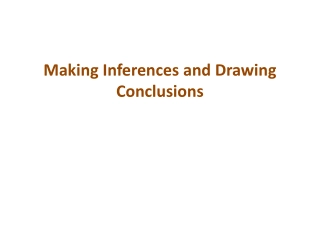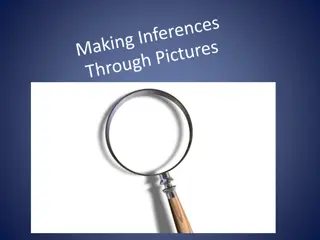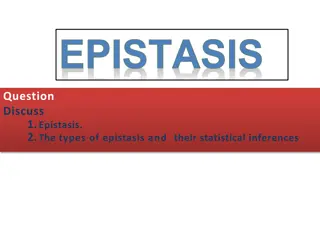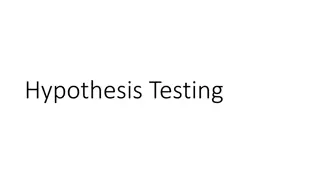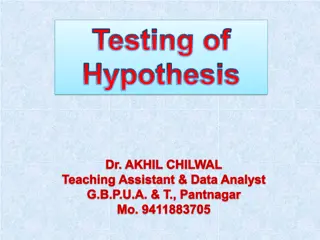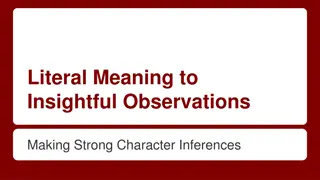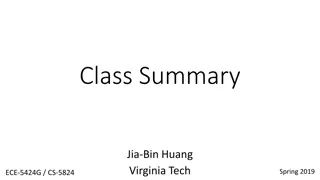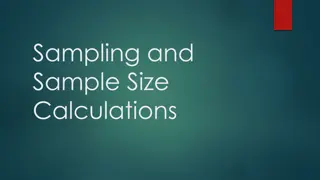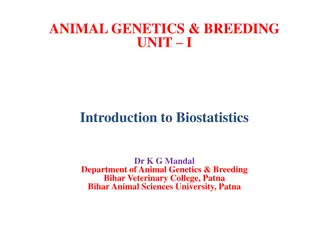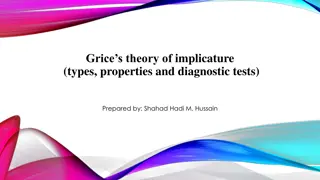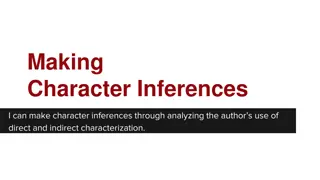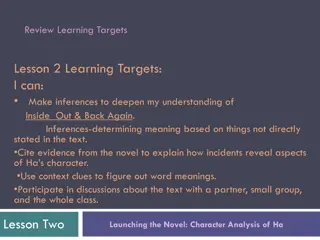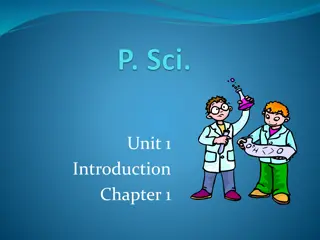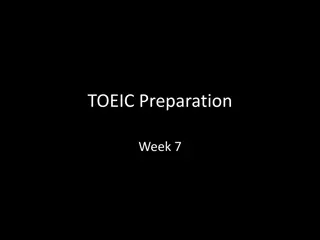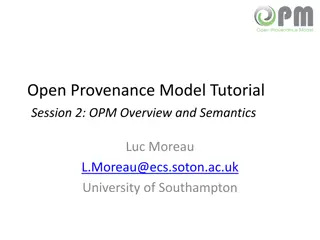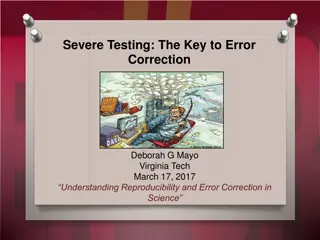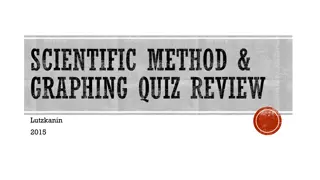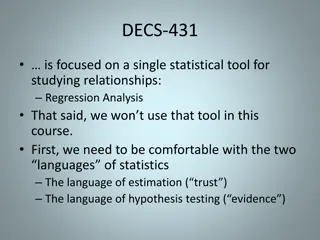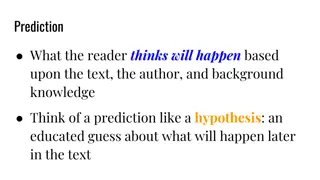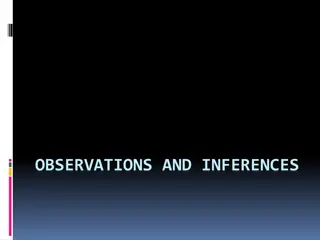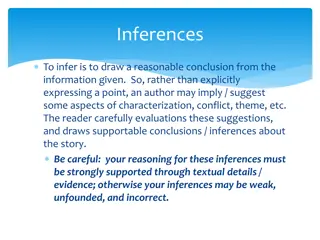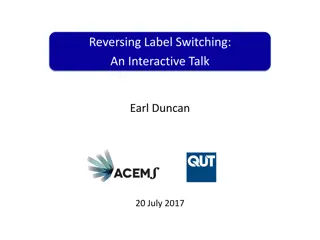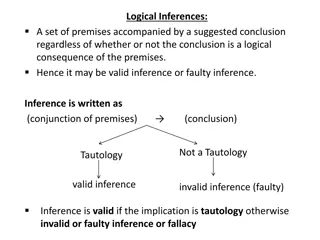Making Inferences and Drawing Conclusions
Readers construct meaning by inferring unstated meanings based on social conventions, shared experience, and shared values. Inferences are evidence-based guesses drawn from what is actually said, enabling readers to understand implications and draw conclusions. Tips for reading include relying on th
0 views • 10 slides
Understanding Sampling Methods in Social Research
Sampling in social research involves selecting a subset of a population to make inferences about the whole. It helps in saving time and money, ensures accuracy in measurements, and allows estimation of population characteristics. The key principles of sampling include systematic selection, clear def
1 views • 19 slides
Understanding Inference and Vyapti in Logic
Inference, known as Anumana in Sanskrit, is the process of deriving knowledge based on existing information or observations. It can be used for personal understanding or to demonstrate truths to others. An inference may be SvArtha (for oneself) or ParArtha (for others). Vyapti, the invariable concom
1 views • 14 slides
Interpretation
Interpretation in research methodology involves drawing inferences from collected data, establishing continuity in research, and developing explanatory concepts for future studies. It helps researchers understand abstract principles, make predictions, and maintain research continuity. Interpretation
4 views • 5 slides
Analyzing Inferences from Visual Cues
Explore a series of visual scenarios and make inferences about the individuals depicted based on their grocery lists, interactions, activities, and emotions. From discerning personal habits to predicting future events, each image provides a unique context for observation and deduction.
0 views • 57 slides
Understanding Epistasis: Types and Inferences
Epistasis is the interaction between genes where one gene's allele masks the expression of another gene. Various types of epistasis, such as dominant and recessive epistasis, can be observed, impacting the phenotypic ratios. Statistical inferences can help analyze epistatic interactions in genetic s
0 views • 35 slides
Reading Comprehension Activities Review
Explore various reading comprehension activities focusing on making inferences, cause and effect, and identifying main ideas. Dive into passages about the gift of giving and family trees, with follow-up questions to enhance understanding and critical thinking skills.
0 views • 37 slides
Understanding Hypothesis Testing and Null vs. Alternative Hypotheses
A hypothesis is a prediction about a study's outcome, guiding research direction. Stating hypotheses forces deep thinking and making specific predictions but may introduce bias. Null hypothesis (H0) states no effect, while alternative hypothesis (Ha) claims an effect in the population. Researchers e
0 views • 7 slides
Understanding Hypothesis Testing in Statistical Analysis
Statistical analysis aims to make inferences about populations based on sample data. Hypothesis testing is a crucial aspect where decisions are made regarding accepting or rejecting specific values or parameters. Statistical and parametric hypotheses, null hypotheses, and decision problems are key c
1 views • 34 slides
Understanding Proportions and Confidence Intervals in Statistics
Explore the concept of proportions in statistics, where the parameter of interest is the percentage of a population with a specific characteristic. Learn how confidence intervals help us assess the reliability of our estimates and how to calculate them using sample statistics. Discover the importanc
0 views • 18 slides
Understanding Research Interpretation and Report Writing in Management Studies
Interpretation in research involves drawing inferences from collected facts to find broader meanings of findings. Techniques such as generalization, concept formulation, and consulting experts help ensure correct interpretation. Writing research reports is a crucial component, requiring logical anal
0 views • 25 slides
Literal vs. Deeper Meaning in Character Inferences
Exploring the difference between literal and deeper meanings in character inferences through examples from Romeo and Juliet. By analyzing quotes and events, readers can uncover hidden motivations and emotions behind characters' actions, providing a richer understanding of the story.
0 views • 4 slides
Machine Learning Algorithms and Models Overview
This class summary covers topics such as supervised learning, unsupervised learning, classification, clustering, regression, k-NN models, linear regression, Naive Bayes, logistic regression, and SVM formulations. The content provides insights into key concepts, algorithms, cost functions, learning a
0 views • 39 slides
Understanding Sampling Methods and Errors in Research
Sampling is crucial in research to draw conclusions about a population. Various methods like simple random sampling, stratified sampling, and systematic sampling help in selecting representative samples. Sampling error arises due to differences between sample and population values, while bias leads
0 views • 12 slides
Understanding Statistics in Animal Genetics and Breeding
Statistics plays a crucial role in analyzing numerical information in the field of Animal Genetics and Breeding. This article introduces the meaning of statistics, its importance, and its application in various fields. It explains how statistics help in presenting data, making logical inferences, an
0 views • 20 slides
Grice's Theory of Implicature: Types, Properties, and Diagnostic Tests
Grice's theory of implicature distinguishes between types of implicatures - conventional and conversational. Conversational implicatures are context-dependent and motivated by conversational maxims, leading to generalized and particularized implicatures. Generalized conversational implicatures are d
0 views • 18 slides
Analyzing Character Inferences Through Direct and Indirect Characterization
Explore the process of making character inferences by analyzing direct and indirect characterization techniques used by authors. Understand how to interpret evidence, reason out claims, and validate your inferences through textual support.
0 views • 12 slides
Understanding Basic Statistics in Research and Evidence-Based Practice
Basic statistics play a crucial role in research and evidence-based practice. Descriptive statistics help summarize data, while inferential statistics make inferences about populations based on samples. Various types of statistics like hypothesis testing, correlation, confidence intervals, and signi
3 views • 15 slides
Exploring Character Analysis and Novel Structure in 'Inside Out & Back Again' Lesson 2
Delve into character analysis of Ha in the novel "Inside Out & Back Again," focusing on making inferences, citing evidence, and using context clues to understand the character deeply. Engage in discussions and activities to uncover the complexities of Ha's personality. Analyze the unique text struct
0 views • 39 slides
Understanding Science: Introduction to the World of Knowledge
Discover the essence of science as a system of knowledge and methods for exploration. Learn about the scientific method, the relationship between science and technology, and key branches of science like chemistry and physics. Explore how science is conducted through observations and inferences, and
0 views • 54 slides
Understanding Bayesian Reasoning: A Comprehensive Overview
Bayesian reasoning involves utilizing probabilities to make inferences and decisions in the face of uncertainty. This approach allows for causal reasoning, decision-making under uncertainty, and prediction based on available evidence. The concept of Bayesian Belief Networks is explored, along with t
1 views • 33 slides
Exploring Inductive Inferences and Their Relation to Probability
Nevin Climenhaga delves into the world of inductive inferences, categorizing them into downward, upward, and sideways forms. He discusses connections with probability, confirmation, epistemic defeat, and more, emphasizing the distinction between direct and indirect forms of inferences.
0 views • 15 slides
Exploring Independence Day: Learning Outcomes and Traditions
Delve into the significance of Independence Day with a presentation by Md. Belayet Hossain, the Assistant Headteacher at Mokamia Secondary School. This lesson focuses on Unit-3 Lesson-5, offering insights into events, festivals, and historical celebrations. Explore the origins, customs, and cultural
0 views • 19 slides
Understanding the ACT Reading Test: Format, Instructions, and Strategies
The ACT Reading Test consists of 40 questions based on 4 passages, to be completed in 35 minutes. It covers prose fiction, humanities, social studies, and natural sciences. This test evaluates your ability to comprehend passages rather than memorize facts. The format includes passages of around 750
2 views • 43 slides
TOEIC Reading Comprehension Strategies and Tips
The TOEIC Reading Comprehension section in Week 7 of preparation focuses on Single Passages with various subjects like business, travel, and technology. It includes different formats such as articles, business correspondence, and announcements. The test consists of 29 questions based on 10 texts, wi
0 views • 26 slides
Introduction to Symbolic Logic: Understanding Logical Inferences
Logic is the study of reasoning methods to distinguish between correct and incorrect arguments. Symbolic Logic involves representing logic symbolically for easier understanding and manipulation. Logical inferences help in making decisions based on reasoning chains. The content discusses the use of l
1 views • 28 slides
Understanding Open Provenance Model (OPM) in Session 2
Dive into Session 2 of the Open Provenance Model tutorial to grasp the abstract model of OPM, its inferences, and efforts to imbue it with semantics. Explore OPM requirements, non-requirements, domain specialization, and its core layers. Discover how OPM allows for precise exchange of provenance inf
0 views • 51 slides
Understanding Error Correction and Reproducibility in Science
Explore the importance of severe testing, statistical crisis of replication, and the American Statistical Association's stance on P-values in ensuring reproducibility and error correction in scientific research. Delve into the philosophical, statistical, and historical aspects of error statistical m
0 views • 63 slides
Quiz Review on Scientific Method and Graphing
Explore a quiz review covering topics related to scientific method, graphing, and experimental design. Understand key concepts such as hypothesis, scientific law, theory, variables, and experimental control through detailed questions and images. Test your knowledge on laboratory safety, inferences,
0 views • 14 slides
Enhancing Reading Comprehension Through Making Inferences
Making inferences is a crucial skill for readers to predict outcomes and understand characters' actions. Textual evidence supports these inferences by providing specific information from the text. In the provided passages about Kyle and Dorothy, readers can infer Kyle's distress from his actions and
0 views • 11 slides
Statistical Analysis: Descriptive and Inferential Techniques Overview
Understanding statistical analysis involves both descriptive and inferential techniques. Descriptive statistics focus on summarizing data, including measures of central tendency and dispersion. In contrast, inferential statistics use sample data to make inferences about populations and test hypothes
0 views • 19 slides
The Girl in the Lavender Dress: Literal Questions and Inferences
Retold by Maureen Scott, "The Girl in the Lavender Dress" is a mysterious tale that challenges readers with literal questions and inferences about the characters and events. From the unusual girl in a lavender dress to the gripping moments in the car, the story unravels with intriguing textual evide
0 views • 7 slides
Understanding the Essence of Statistics in Decision-Making
Statistics plays a crucial role in making informed decisions by drawing inferences from data collected from a sample to represent a larger population. It involves two key languages: estimation (trust) and hypothesis testing (evidence). By understanding the fundamentals of statistics, managers can na
0 views • 42 slides
Understanding Categorical Data Analysis for Proportion Estimation
In the realm of categorical data analysis, estimating proportions is crucial for understanding population characteristics. This involves sampling, calculating sample proportions, standard errors, and constructing confidence intervals. Through examples like studying the effects of treatments on medic
0 views • 72 slides
Categorical Data Analysis in Population Studies
Inference methods for estimating proportions in a population are essential in categorical data analysis. This includes techniques for single proportions, confidence intervals, sample size determination, and Wilson-Agresti-Coull method for small sample sizes. Illustrated with examples and visuals, th
0 views • 80 slides
Enhancing Reading Comprehension: Predictions vs. Inferences
Understanding the distinction between predictions and inferences in reading comprehension is key. While predictions focus on what will happen in a story, inferences delve into analyzing clues to make informed guesses about characters, feelings, and actions. Readers can actively engage in making pred
0 views • 6 slides
Understanding Observations and Inferences in Science
Observations involve using the five senses to gather accurate and specific information, while inferences are explanations based on observed facts, not opinions or guesses. Learn to make your own inferences with examples provided.
0 views • 4 slides
Understanding Literary Elements: Inferences, Vocabulary, and Character Development
Inferences involve drawing conclusions from implied information; vocabulary in context aids in understanding unfamiliar words; juxtaposition compares or contrasts elements; characterization and character development reveal a character's traits and growth; static characters remain unchanged, while dy
0 views • 65 slides
Understanding Label Switching in Bayesian Mixture Models
In the interactive talk "Reversing Label Switching" by Earl Duncan, the concept of label switching in Bayesian mixture models is explored. Label switching poses challenges in making accurate inferences due to symmetric modes in posterior distributions. Duncan discusses conditions for observing label
0 views • 13 slides
Understanding Logical Inferences and Rules of Inference
Logical inferences involve drawing conclusions from premises, which can either be valid or invalid based on the rules of inference. This includes Modus Ponens, Hypothetical Syllogism, DeMorgan's Law, and Law of Contrapositive. Invalid inferences result in fallacies like denying the antecedent. Exerc
0 views • 18 slides
